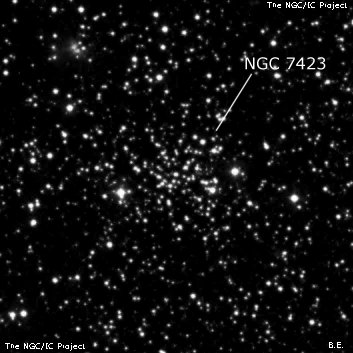
William Herschel discovered NGC 7423 = H III-745 = h2191 on 1 Nov 1788 (sweep 876) and noted "pL, irr figure, easily resolvable, or a very distant patch of the milky way." His RA is 50 seconds too large. JH recorded "A large patch of the milky way, consisting of stars so small as to be quite nebulous. If this be not III 745, I find no other." Dreyer used JH's position in the NGC but commented in his 1912 "Scientific Papers of William Herschel" that William's and John's positions differ by about 1 tmin, so the two entries may refer to different objects. RNGC lists the number as nonexistent, though the cluster is also catalogued as Berkeley 57. See Corwin's notes for discussion.
400/500mm - 18" (9/24/05): at 225x, this cluster appears as a small, rich, glowing spot 2' in diameter, peppered with roughly a dozen mag 14-15 stars, several of which are just on the edge of visibility. Set within a rich low power Milky Way star field, although noticed immediately at 115x. A wide pair of mag 11 stars is just off the SW side. At 435x, the faint resolved stars are easier to view, although the background glow fades. Planetary nebula M 1-80 is just 10' ENE. M 1-80 was easily picked up by blinking at 160x with an OIII filter, although appears slightly soft at this power unfiltered. Excellent view at 538x unfiltered as a slightly irregular small disc, ~4" diameter. Situated ~40" W of a mag 11 star. A very close pair of mag 14.5-15 stars follows the mag 11 star and a brighter double is close north.
Notes by Steve Gottlieb